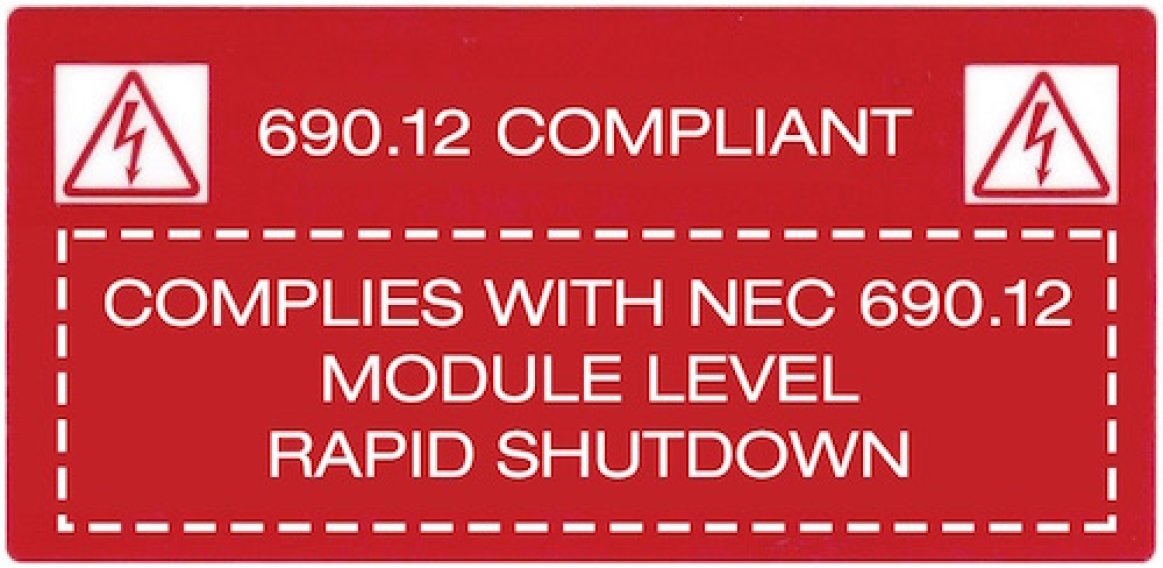
NEC 2014: Article 690.12 “Rapid Shutdown of PV Systems on Buildings”
There were several changes to the 2014 NEC code that affect PV systems. Of these changes, the most notable is article 690.12 that focuses on rapid shutdown of roof mounted PV systems. This new requirement can have a major impact on whether a system is capable of meeting this new code requirement.
What is 690.12 all about?
To answer that question simply; Safety. The most potentially dangerous element to first responders or firefighters is the DC conductors from PV arrays that they could accidentally come into contact with while trying to put out a building fire.
The DC conductors that make up each string between the array and the inverter pose this hazard. While an inverter can be shut down during an emergency the DC side can still be energized. What that means to the emergency responder is that by chopping through walls or the roof there is a potential of making direct contact with these DC conductors and we can all agree this would not be a very pleasant experience for anyone.
Article 690.12 means to address this hazard by making it a requirement that this DC source is able to be shutdown so that these first responders are not in direct danger of electrical shock while they are performing their duties.
The 2014 NEC Handbook explains, “First responders must contend with elements of a PV system that remain energized after the service disconnect is opened. This rapid-shutdown requirement provides a zone outside of which the potential for shock hazard has been mitigated. Conductors more than 5 feet inside a building or more than 10 feet from an array will be limited to a maximum of 30 V and 240 VA within 10 seconds of shutdown.”

Rapid Shutdown Midnight Solar Birdhouse
I imagine this is where many are asking the question, “How am I going to be able to do that?” Well, if you’re using micro-inverters and AC modules (Module Level Electronics or MLE’s) you are likely conforming to this requirement already since most will be de-energized as soon as the grid or the power from the grid is interrupted. It’s a happy coincidence in systems that use these devices that nothing more need be added or incorporated into the system.
What about string inverters?
Most string inverters will fall victim to this new requirement and would be ruled out. However, there are a few installation methods for string inverters that can be considered that still keep them as viable inverter options for new systems.
The first method is to install the inverter near the PV arrays so that the DC conductors terminate within 10 feet of the PV array. This method works best on commercial or flat rooftops where it is easily accessed for service and can be shielded from direct sunlight. After all, you want to get the best possible performance out of your inverter and we know they do not like heat.
The second method would be to install the inverter indoors, if possible, and within 5 feet of the array. This option is appealing because the inverter would not be as exposed to the elements and/or temperature extremes which could cause losses in energy yield. Unfortunately in some circumstances this may not be possible to do.
The third methods is a system that incorporates equipment that directly addresses the rapid shutdown issue or off-the-shelf contractors that make/break the DC circuit where the switch or button that controls it is conveniently located near the main service disconnect would be.
There are products out there now that have been developed for string inverters that does just that. Many inverter manufactures have already developed a solution for rapid shutdown while others have products that will become available very soon.
As with new code adoption comes new labeling and 690.12 is no exception. According to a later article, 690.56(C) a placard should be provided that reads “Photovoltaic System Equipped with rapid shutdown” and it should be placed where first responders are trained to go first to cut off the electricity during a fire. This has been left to the interpretation of the authority having jurisdiction (AHJ), giving the option of identifying where it is to be place. This generally will be where the main service disconnect or meter are located.
Will I be affected by this?
See if your state has adopted the NEC 2014 and follow up with your AHJ to confirm what code year is being utilized.